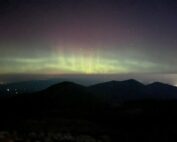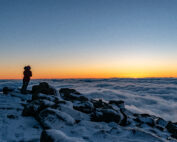Mount Washington’s Iceberg
2015-05-22 17:10:10.000 – Will Hatheway, Intern
Of course one of the most fascinating things about this picture is the layers of ice and their different colors. Water is a fascinating substance by how the properties of freezing change according to temperatures. When water freezes near 32F/0C, it takes on a whitish color due to the crystalline structure of the ice. Towards the bottom of the ice it is clear like glass. This occurs when water freezes well below the freezing level and the crystalline structure is very organized. We can actually use these layers to help identify when in time they froze. During the early part of winter, Mount Washington was very cold with several weeks at or below zero. Having that knowledge we can then determine that the ice clear block occurred during that time and then each layer afterward could be connected to an event.
Will Hatheway, Intern
From Weather Observer to Intern, to Observer Again
From Weather Observer to Intern, to Observer Again By Madelynn Smith As I rode in the backseat of our Obs van up the Auto Road for the first time as a full-time employee at
From Mountains to More Mountains
From Mountains to More Mountains: This Time with Stronger Winds By Alyssa Bélanger On the observation deck in high winds. Hello there! My name is Alyssa Bélanger and I am a fall
From Summit to Sign-Off: My Farewell to the Rockpile
From Summit to Sign-Off: My Farewell to the Rockpile By Amy Cotter Enjoying my last Mount Washington sunset (for now) on September 13, 2025. After two incredible years with the Mount Washington




